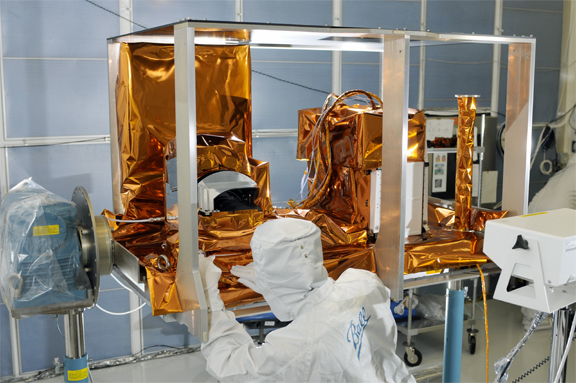
[SatNews] All five instruments that will fly on NOAA’s next-generation Joint Polar Satellite System (JPSS) JPSS-1 satellite are now in the "environmental testing" phase, bringing it closer to its planned launch in early 2017.

The Ozone Mapping and Profiler Suite (OMPS) instrument undergoes post thermal inspection at a Ball facility in Boulder, Colo.
Photo is courtesy of Ball Aerospace & Technology Corp.
Environmental testing subjects the instruments to tests that simulate the launch and space environments to ensure the instruments are meeting their requirements for the rigor of operating in space.
The instruments are
- Advanced Technology Microwave Sounder (ATMS)
- Cross-track Infrared Sounder (CrIS)
- Visible Infrared Imaging Radiometer Suite (VIIRS)
- Ozone Mapping and Profiler Suite (OMPS) and Clouds
- Earth’s Radiant Energy System (CERES)
Together these instruments will enhance Earth observations from the polar-orbit and improve NOAA’s ability to predict severe weather three- to seven-days in advance.
"This milestone is important because it means we’re meeting the program milestones and moving closer to launching JPSS-1—on budget and on schedule," said JPSS Director Harry Cikanek. "With each instrument progressing through environmental testing, we are moving toward delivery. After completion of the test phase, each instrument will undergo a pre-shipment review, confirming they are ready to be transferred for installation onto the spacecraft."
All of the JPSS instruments are scheduled to be shipped in early 2015 when instrument integration is scheduled to begin on the JPSS-1 spacecraft. JPSS, which is replacing NOAA’s current fleet of polar satellites, is a collaboration between NOAA and NASA. JPSS provides continuity of critical, global Earth observations, including ocean, clouds, ozone, snow, ice, vegetation and atmosphere.

